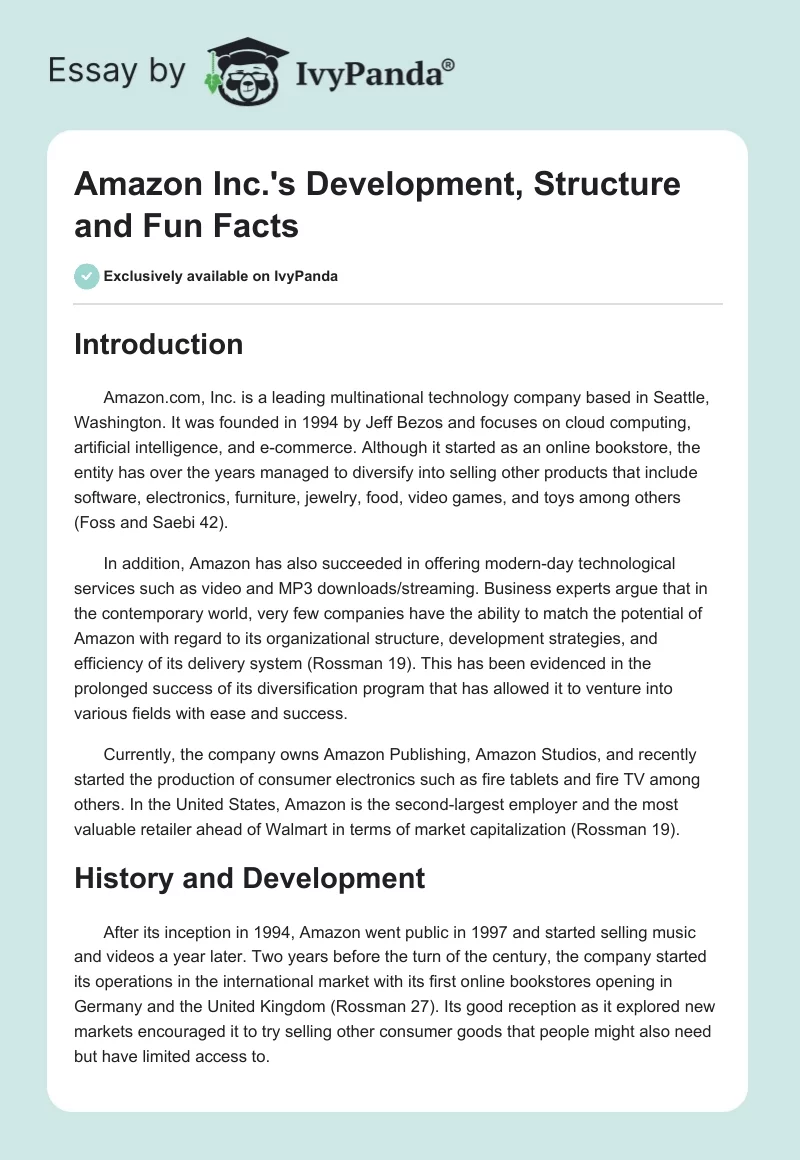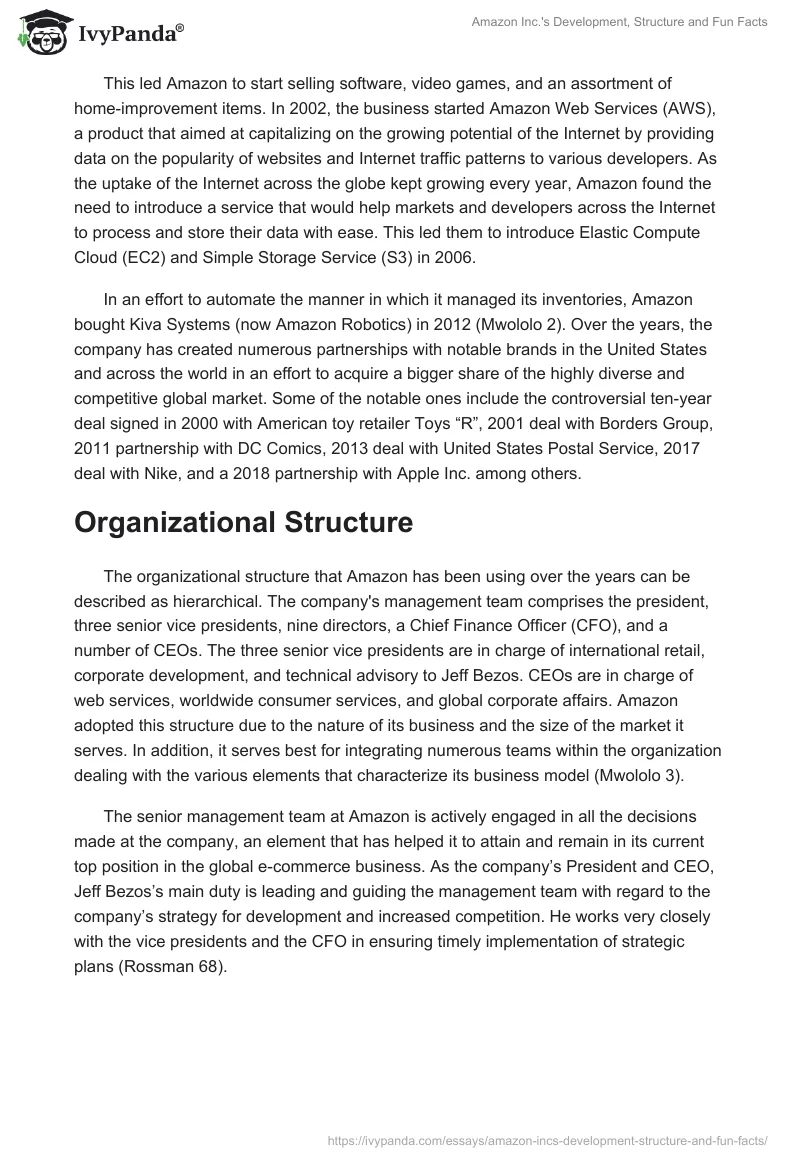Introduction
Amazon.com, Inc. is a leading multinational technology company based in Seattle, Washington. It was founded in 1994 by Jeff Bezos and focuses on cloud computing, artificial intelligence, and e-commerce. Although it started as an online bookstore, the entity has over the years managed to diversify into selling other products that include software, electronics, furniture, jewelry, food, video games, and toys among others (Foss and Saebi 42).
In addition, Amazon has also succeeded in offering modern-day technological services such as video and MP3 downloads/streaming. Business experts argue that in the contemporary world, very few companies have the ability to match the potential of Amazon with regard to its organizational structure, development strategies, and efficiency of its delivery system (Rossman 19). This has been evidenced in the prolonged success of its diversification program that has allowed it to venture into various fields with ease and success.
Currently, the company owns Amazon Publishing, Amazon Studios, and recently started the production of consumer electronics such as fire tablets and fire TV among others. In the United States, Amazon is the second-largest employer and the most valuable retailer ahead of Walmart in terms of market capitalization (Rossman 19).
History and Development
After its inception in 1994, Amazon went public in 1997 and started selling music and videos a year later. Two years before the turn of the century, the company started its operations in the international market with its first online bookstores opening in Germany and the United Kingdom (Rossman 27). Its good reception as it explored new markets encouraged it to try selling other consumer goods that people might also need but have limited access to.
This led Amazon to start selling software, video games, and an assortment of home-improvement items. In 2002, the business started Amazon Web Services (AWS), a product that aimed at capitalizing on the growing potential of the Internet by providing data on the popularity of websites and Internet traffic patterns to various developers. As the uptake of the Internet across the globe kept growing every year, Amazon found the need to introduce a service that would help markets and developers across the Internet to process and store their data with ease. This led them to introduce Elastic Compute Cloud (EC2) and Simple Storage Service (S3) in 2006.
In an effort to automate the manner in which it managed its inventories, Amazon bought Kiva Systems (now Amazon Robotics) in 2012 (Mwololo 2). Over the years, the company has created numerous partnerships with notable brands in the United States and across the world in an effort to acquire a bigger share of the highly diverse and competitive global market. Some of the notable ones include the controversial ten-year deal signed in 2000 with American toy retailer Toys “R”, 2001 deal with Borders Group, 2011 partnership with DC Comics, 2013 deal with United States Postal Service, 2017 deal with Nike, and a 2018 partnership with Apple Inc. among others.
Organizational Structure
The organizational structure that Amazon has been using over the years can be described as hierarchical. The company’s management team comprises the president, three senior vice presidents, nine directors, a Chief Finance Officer (CFO), and a number of CEOs. The three senior vice presidents are in charge of international retail, corporate development, and technical advisory to Jeff Bezos. CEOs are in charge of web services, worldwide consumer services, and global corporate affairs. Amazon adopted this structure due to the nature of its business and the size of the market it serves. In addition, it serves best for integrating numerous teams within the organization dealing with the various elements that characterize its business model (Mwololo 3).
The senior management team at Amazon is actively engaged in all the decisions made at the company, an element that has helped it to attain and remain in its current top position in the global e-commerce business. As the company’s President and CEO, Jeff Bezos’s main duty is leading and guiding the management team with regard to the company’s strategy for development and increased competition. He works very closely with the vice presidents and the CFO in ensuring timely implementation of strategic plans (Rossman 68).
Reasons for its Success
Business experts argue that one of the main factors behind the prolonged success of Amazon is its organizational structure, as well as corporate culture and values. Amazon believes in the spirit of togetherness, closeness, and teamwork. These values help to give any organization a competitive advantage in the market, which in turn builds a solid foundation for development and prolonged success.
The contemporary business environment is highly diverse and competitive, thus requiring entities to be innovative when it comes to their recruitment strategies and the nature of business models. Amazon’s corporate culture is developed from the values of promoting innovation, diversification, competition and achieving high levels of flexibility (Rossman 89). Technological advancements such as the Internet have created numerous business opportunities, as evidenced in several e-commerce services that Amazon currently offers.
Another major factor that has contributed to the success of Amazon is the visionary and efficient leadership of Jeff Bezos. He has been described as a strategic, aggressive, and forecasted contemporary business leader who is not afraid of venturing into business environments that have not been tested before (Foss and Saebi 88). Reports indicate that Bezos is a strong supporter of the business diversification strategy that the company adopted several years ago.
This strategy has also been widely considered to play a pivotal role in the successful expansion activities that Amazon has undertaken over the years (Rossman 107). Business experts argue that the ability of a business to spread its risks through diversification helps to manage the negative impacts associated with the numerous changes that happen in the external business environment.
Fun Facts and Notable Mentions
Many Amazon customers across the world know very little about their favorite service provider. First, the company was actually created in the home garage of its founder in Bellevue, Washington. According to Bezos, the initial name he had chosen for the company was Cadabra but failed to get the magical feeling he wanted from its sound. The very first book that was sold at Amazon was Fluid Concepts and Creative Analogies authored by Douglas Hofstadter.
An interesting tradition at the company during its infancy days was that a bell would be rung at every purchase made in the office. Reports indicate that in 1997, the company was sued by Barnes & Noble over what they claimed was a slogan that did not depict the reality that the business was experiencing (Foss and Saebi 119). Amazon was accused of stating in its slogan that it was the earth’s largest bookstore yet at the time, it was not the case.
Another interesting fact about Amazon is the fact that a group of employees at the time when the company started experiencing growth worked for a minimum of sixty hours every week. As part of its efforts to help the workplace environment, Amazon uses robots to assist its warehouse workers in retrieving items. Interestingly, employees at Amazon consider their CEO to be a tough boss who will explode at employees anytime he gets substandard work or a report. In 2013, the company is said to have lost over $4 million in less than one hour when its website went down (Rossman 51).
Over the years, Amazon has been actively engaged in lobbying both federal and state governments in the United States on matters relating to the taxation of online sales, intellectual property, as well as the safety and privacy of data transferred through online transactions (Foss and Saebi 120). In addition, the company has been entangled in several controversies that have threatened to compromise its reputation.
Some of the notable controversies have revolved around the issues of environmental impact, the selling of counterfeit items, and income taxes among others. In the recent past, the company has received much backlash from President Donald Trump over the deal that it signed with the United States Postal Services. Amazon has also come under scrutiny over recent comments made by Vermont Senator Bernie Sanders who accused it of poor working conditions and low wages for its employees.
Conclusion
Amazon is a leading global brand that has proven its abilities in dealing with diversification and investing in areas that many businesses are not willing to risk their resources on. Through the leadership of Jeff Bezos, the company has managed to dominate the e-commerce market across the world.
Works Cited
Foss, Nicolai, and Tina Saebi. Business Model Innovation: The Organizational Dimension. Oxford University, 2015.
Mwololo, Harry. Business Model of Amazon. GRIN Publishing, 2018.
Rossman, John. The Amazon Way on IoT: 10 Principles for Every Leader from the World’s Leading Internet of Things Strategies. Clyde Hill Publishing, 2016.


